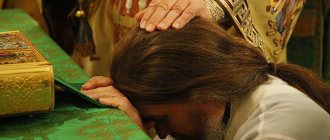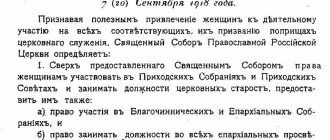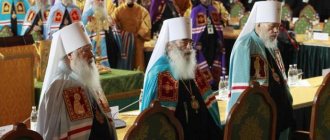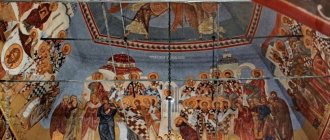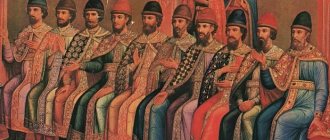Incapacity for the priesthood.
Priests are the spiritual leaders and mentors of the people of God. Therefore, candidates for the priesthood must be distinguished by the depth and strength of their faith, high moral qualities, and impeccable reputation. Not all Christians can be ordained or placed in the clergy. Candidates for the priesthood must meet certain qualifications. Their failure to meet these requirements serves as an obstacle to the priesthood.
Catholic law distinguishes between the so-called absolute incapacity of consecration (incapacitas) and irregularity (irregularitas), i.e. a defect that is an obstacle to ordination, which, however, allows for dispensation (deviation from strict observance of the law) by the competent ecclesiastical authority.
In the case of absolute inability, the ordination is unacceptable, and if it is actually performed, it is still recognized as invalid and insignificant. This still cannot be said about ordination performed in the presence of one or another deficiency in the person being ordained, regarded as “incorrectness.” In general, the distinction between two types of obstacles is also accepted in Orthodox church law.
Unbaptized persons and women are certainly incapable of the priesthood. Unbaptized persons are not members of the church, so obviously they cannot be part of its hierarchy.
As for women, then, according to the words of the Apostle Paul, “Let your wives remain silent in the churches; for it is not lawful for them to speak, but to be in subjection, just as the law says.”
(I Cor. 14:34). This does not mean, of course, that women cannot serve in church or sing in the choir. Women parishioners are not excluded from managing economic affairs in the parish, as well as from serving in various church institutions not related to the priesthood. As for the deaconesses and presbyteresses of antiquity, they, of course, were not hierarchical persons.
Origin and meaning of the term
The very word “ordination” contains the visible meaning of the entire rite, since it is carried out by the bishop laying hands on the head of a person who wishes to be ordained. At the same time, special prayers corresponding to the given moment are read. This custom has ancient roots and dates back to the time of the Apostles. According to the teachings of Christians, a special energy is believed to be transmitted through it - Divine fire, the grace of the Holy Spirit.
Ordination is an act that symbolizes ecclesiastical succession. The apostles received their power and rights (priesthood) from Christ, and then transferred them in this manner to their followers. Orthodox Christians also call such a ritual ordination.
Types of obstacles.
Some canonists divide obstacles to the priesthood into those that are caused by the shortcomings of the person being ordained, and obstacles associated with the commission of crimes. “Another category of canonical obstacles,” noted A. S. Pavlov, “has as its source crimes or such acts of a member of the Church that, if not from the point of view of criminal law, then from the point of view of canon law, should be recognized as crimes. These include; 1) falling away from the faith, not forced by torment (Apostle 62, I Om. 10, Ankyr. 3); 2) heresy... (I Universe 19, Canonical Epistle of Athanasius to Ruthian); 3) emasculation of oneself and others; 4) all so-called carnal sins, consisting of violation of the seventh commandment of the Law of God (Apostle 61, Neoces. 9, 10). Those guilty and found guilty of all these crimes, according to ancient church rules, were subject to public repentance. Hence the general canonical position; “Whoever has once undergone public church repentance is forever excluded from ordination to the ecclesiastical hierarchical ranks.”
In practice, the distinction between defects, for example, of the moral order, and the so-called defects of faith, on the one hand, and crimes, on the other, is difficult to make, since the latter are impossible without the former. Therefore, when classifying obstacles to the priesthood, it is more convenient to divide them differently: 1) obstacles of a physical nature; 2) obstacles of a spiritual nature; 3) obstacles of a social nature.
How the ritual is performed
The procedure, according to custom, is performed at the time of the divine liturgy and takes place on the altar of the temple. During it, prayer chants corresponding to this solemn occasion are sung in chorus. In this case, the person being ordained walks around the holy throne three times, then kneels on the right side in front of him. And the bishop or council of bishops performs the prescribed ritual.
According to the laws of Orthodoxy, consecration for a priest and a bishop can be performed on any of the days when a full liturgy is held with the so-called Eucharistic canon. Ordination to the rank of deacon is also permitted at the Liturgy of the Presanctified Gifts. But on each day only one person should be ordained.
Physical obstacles.
Among them, some are related to age, while others are related to the health or physical disabilities of the protege.
To perform hierarchical and even clerical service, maturity of mind, firmness of convictions, and known life experience are required, which require reaching a certain age.
For appointment to the rank of deacon, the canons set the age of 25 years, and for the appointment of a presbyter - 30 years. Canon 14 of the Trullo Council reads: “...so that one should not ordain a presbyter before he is thirty years old, even if the person were very worthy, but defer it until his appointed years. For the Lord Jesus Christ was baptized in the thirtieth year and began to teach. Likewise, a deacon before twenty-five years of age, and a deaconess before fourty years of age, should not be appointed.”
The 15th canon of the same Council says: “Let a subdeacon not be appointed before twenty years of age. If anyone is placed in any sacred degree before certain years, let him be deposed.”
In practice, however, both in ancient times and in modern times, deviations from this rule were and are allowed. In any case, the facts of the application of sanctions provided for by the 15th rule of the Trullo Council are almost unknown.
As for the age of persons appointed as bishops, the canons are silent about this. The ancient “Apostolic Constitutions” (11, 1) stipulate that a candidate for bishop must be 50 years old. Photius’ “Nomocanon” (Tit. 1:23) contains a provision from Justinian’s novella 123, which establishes a 35-year age limit for a candidate for the highest hierarchical degree, and in exceptional cases – a 25-year age limit. But church history knows of deviations from this norm, and even quite significant ones. There have been cases of people under 20 years of age being appointed bishops.
The canons also say nothing about the age of readers appointed to the rank. The 123rd story of Justinian, included in an abbreviation in the “Nomocanon,” allows 8-year-old children to be included as readers. And Balsamon, in his interpretation of the corresponding chapter of the Nomocanon, writes that sometimes 3-year-old babies were appointed readers. According to the current Statute of the Russian Orthodox Church, deacons and elders can be ordained upon reaching civil adulthood (i.e., at 18 years of age), and candidates for episcopacy must be at least 30 years of age.
Physical disabilities and illnesses in themselves cannot serve as an obstacle to initiation. The only obstacles are those physical defects that make priestly service difficult. The 77th Apostolic Canon says: “If anyone is deprived of an eye, or has an injury in his legs, but is worthy to be a bishop: let him be. For physical defect does not defile him, but spiritual defilement.” And in the 78th Apostolic Canon it says: “Let no one who is deaf or blind be a bishop, lest he be defiled, but let him not be an obstacle in church affairs.” As A. S. Pavlov noted, “according to the meaning of this general rule, questions about the armless, legless, and those possessed by epilepsy or incurable mental illness must be resolved.”
As for the eunuchs, according to the 1st rule of the First Ecumenical Council, “Whoever has his limbs taken away by doctors due to illness, or who has been castrated by the barbarians, let him remain in the clergy. If, being healthy, he castrates himself, such a person, even if he was ranked among the clergy, should be expelled.”
According to Zonara’s interpretation, “not only the one who cut off this member with his own hands is called emasculated, but also the one who voluntarily and without coercion gives himself to another for emasculation.”
On the basis of the 79th Apostolic Canon, persons suffering from mental illness are not allowed into the clergy: “If anyone has a demon, let him not be accepted into the clergy, but let him pray below with the faithful. Having been freed, let him be accepted with the faithful, and if he is worthy, then let him be admitted to the clergy.”
Catholic law broadly interprets the conditions for ordination related to physical disabilities, prohibiting the ordination of the hunchbacked, lame, dwarfs, deprived of the left eye (the so-called canonical eye - oculus canonicus), as well as the index finger of the right hand.
Episcopal ordination
Since ancient times, the rite of consecration to bishops was considered extremely responsible and important and became possible only for ministers of presbyteral dignity, that is, for persons at the second level of the church hierarchy. In the old days, the election and confirmation of a new bishop was carried out by all the bishops and the people, who had to consult and decide that he was worthy.
Currently, his candidacy is being proposed and considered by the Holy Synod and the patriarchs. And on the day before consecration, the newly elected bishop undergoes a test, after which the rite of consecration is performed, and the people bless the newly consecrated.
Obstacles of a spiritual nature.
They are associated either with shortcomings of faith in the protege, or with his moral vices, or, finally, with the lack of necessary knowledge.
The faith of a candidate for the priesthood must be strictly Orthodox, deep, firm, and active. The lack of firmness in faith is evidenced by the previous falling away from the Church. Therefore, the 10th canon of the First Ecumenical Council says: “If some of the fallen are promoted to the clergy, out of ignorance, or with the knowledge of those who did so: this does not weaken the power of the church rule. For such, upon inquiry, are expelled from the sacred rank.”
According to Zonara’s interpretation, “those who rejected our Lord Jesus Christ and then repented should not be promoted to the priesthood. For how can one be a priest if he is not honored with the Holy Mysteries throughout his life, except at death?”
It is natural to assume a lack of faith in those who turn to it in exceptional circumstances, for example, due to fear of death in the event of a serious illness - in the so-called “clinics.” However, in the cases of “clinics” we are not talking about an unconditional ban on ordination. The 12th rule of the Neocaesarea Council says: “If someone is enlightened by baptism in illness, he cannot be promoted to the rank of presbyter: for his faith does not come from will, but from need; perhaps only for the sake of later revealed virtue and faith, and for the sake of poverty in worthy people.”
Those candidates for the priesthood are also subject to careful consideration. who turned to our faith from heresy. In the 19th canon of the 1st Council of Nicaea, it is said about the former Paulians that they, “having been found blameless and without blame, after rebaptism, may be ordained.”
Finally, a lack of faith is also assumed in new converts - neophytes. The Apostle Paul wrote to Timothy about the bishop that he “must not be one of the new converts, lest he become proud and fall into condemnation with the devil.”
(1 Tim. 3:6).
The 80th Apostolic Canon reads: “It is not right for someone who has come from a pagan life and been baptized, or who has converted from a vicious way of life, to suddenly be promoted to bishop. For it is unfair for someone who has not yet been tested to be a teacher of others: unless by the grace of God this will be arranged.” According to the 2nd rule of the First Ecumenical Council; This norm also applies to elders, and, in accordance with the 3rd rule of the Council of Laodicea, to the entire priesthood in general: “It is not appropriate for those recently baptized to be promoted to the priestly rank.”
A lack of firmness of the Christian faith can also be suspected in someone who was unable to convert all of his household, for, according to the words of the Apostle Paul, one who “has faithful children”
(Tit. 1:6). The 45th canon of the Council of Carthage states: “Bishops and presbyters and deacons should not be appointed until they have made everyone in their house Orthodox Christians.”
The faith of the protege must be expressed in his life and deeds. Faith without works is dead - teaches the Apostle James (James 2:17). Therefore, the 12th canon of the Council of Laodicea demands: “Bishops... to be placed in the leadership of the church... are those who have long been tested both in the word of faith and in living in accordance with the right word.”
Serious sins, for which those guilty in the Ancient Church were subject to public repentance, constitute an obstacle to the priesthood. Such sins include murder, theft, grave digging, sacrilege (6 rights. Grig. Nissk.), fornication, adultery, sodomy. The 61st Apostolic Canon reads: “If a faithful person is accused of fornication, or adultery, or any other forbidden act, and is convicted, let him not be brought into the clergy.”
Humility, peacefulness, and meekness are required from ministers of the Church. The Apostle Paul teaches: “The bishop must be blameless, as God’s steward, not arrogant, not wrathful, not a drunkard, not a murderer, not a covetous man, but a lover of hospitable things, a lover of good, chaste, just, godly, self-controlled” (Titus 1:7- 8).
Church rules do not allow even unwitting murderers into the clergy (Vas. Vel. 43; 5 rights. Grig. Nissk.). According to the 14th rule of Basil the Great, a moneylender can only be accepted into the clergy “if he desires to squander unrighteous gain on the poor, and henceforth be free from the disease of covetousness.”
A candidate for the priesthood is required to be a teacher and to have the ability to instruct his flock. In the Epistle to Titus the apostle says that the bishop must be “Strong to teach in sound doctrine and to rebuke those who resist.”
(Titus 1:9). And this requires thorough preparation, a firm knowledge of religious doctrine.
The 2nd rule of the VII Ecumenical Council says: “...Everyone who has been elevated to the episcopal rank must certainly know the Psalter, and so admonishes all his clergy to learn from it. “Then the Metropolitan should carefully test whether he is diligent, with reflection, and not in passing, to read the Holy Rule and the Holy Gospel, and the book of the Divine Apostle, and all the Divine Scripture, and the postulates according to the commandments of God, and teach the people entrusted to him.” The requirements for bishops to be well-read in the Holy Scriptures and canons, expressed in this rule, are not high. Balsamon explained this in his interpretation of the rule in question by the difficult circumstances in which the Orthodox Church lived in the iconoclastic era that preceded the convening of the VII Ecumenical Council.
At present, candidates for the priesthood are mainly trained in theological schools, but necessity forces those who have not received a special theological education to be admitted to the sacred degrees, although not without appropriate testing of their knowledge of dogmas, basic rules and liturgical regulations.
Ordination in Judaism
The rite of ordination in Judaism was called “smicha”. The word itself is also translated from Hebrew. Thus, in ancient times, rabbis were given not only religious, but also legal powers, that is, the right to hold court, resolve financial issues, and influence people’s destinies with their authority. That is, it turned out that ordination is approval for a certain responsible type of activity. It was believed that when judges sit, God is invisibly present among them.
The ancients believed that a person accepting ordination must have truthfulness, fear of God, wisdom, hate self-interest and have a good education. The rite of smikha itself was accompanied by a festive ceremony. And the hero of the occasion addressed the people with a solemn speech and received in response congratulations on his ordination.
Social obstacles.
Some of them relate to the marital status of the protege, others - his duties to the state, and others - his public reputation.
Unlike Catholic law, Orthodox church law does not recognize illegitimacy as an obstacle to ordination. In the 8th rule of St. Nikephoros the Confessor, which is placed in the Pidalion and the Athenian Syntagma, says: “Children born of concubines or second or third marriages, if they lead a life worthy of the priesthood, can be clergy.”
Therefore, the judgment of N. S. Suvorov, who believed that in “Eastern canon law the requirement from the initiate to be legitimate” is only “not expressed with such clarity as in Western law,” is unfounded. In Eastern church law such a requirement does not exist at all. At the same time, without taking into account the origin of the person being ordained, the Church makes strict demands regarding his behavior in marriage. Church laws do not allow second-weds into the clergy. “Whoever, by holy baptism, was obliged to marry two times, or had a concubine, cannot be a bishop, nor a presbyter, nor a deacon, or lower in the list of the Holy Order,” says the 17th Apostolic Canon.
Explaining this canon, Zonara o
The Church has made demands of unconditional monogamy on candidates for the priesthood since ancient times. Patriarch of Alexandria St. John the Merciful in 641, in response to a rich man from his second marriage, who promised to donate a large sum for the hungry in gratitude for his ordination to the deacon, said: “It is better to extinguish the sun than to violate the Divine law.” And the Kiev Metropolitan Peter Mohyla in 1663 responded to the nobles who asked not to deprive newlyweds of their rank: “I could not do this if an angel from heaven said this.”
Since absolute monogamy is required from the protege, even marriage to a widow or a woman abandoned by her husband, i.e. so-called passive bigamy constitutes an obstacle to the priesthood. The 18th Apostolic Canon says: “Whoever takes into marriage a widow, or an outcast from marriage, or a harlot, or a slave, or a disgraceful (actress. - V. Ts). There cannot be a bishop, nor a presbyter, nor a deacon, lower at all in the list of sacred ranks.”
Persons who continue to cohabit with a wife caught in adultery are also not allowed to be ordained: “If the wife of a certain layman, having committed adultery, is clearly convicted of it, then he cannot come into church service. If, after the husband’s ordination, he falls into adultery, then he must divorce her, but if he cohabits, he cannot touch the service entrusted to him” (8 rights. Neoces. Sob.).
The marriage of a priesthood candidate must not only be monogamous, but also unblemished in other respects. Based on the 19th Apostolic Canon, the priesthood is forbidden to those who marry a close relative - a niece. And the 36th (45) rule of the Carthage Council does not allow for ordination of persons related by marriage to non-Christians and, in general, to non-Orthodox wives.
All these requirements apply only to lower clergy, deacons and presbyters, for for bishops, according to the 13th rule of the Trullo Council, celibacy is mandatory.
In the Catholic Church, since the time of Pope Gregory VII, all clergy are bound by a vow of celibacy. However, in the Roman Church, celibacy was established earlier, when it still maintained unity with Ecumenical Orthodoxy, although its obligatory nature is rejected by the canons (13 rights. Trull. Sob.),
A candidate for the priesthood must be free from performing such duties to the state that are incompatible with priesthood.
According to the 81st Apostolic Canon, bishops, or presbyters, are not allowed to engage in “affairs of public administration,” and the 83rd Apostolic Canon reads: “A bishop or presbyter or deacon who trains in military affairs and wants to retain both, that is, the Roman authorities and priestly office, may he be expelled from the sacred order. For Caesar is Caesar’s, and God’s God.”
In ancient times, when slavery existed, slaves were also prohibited from the priesthood (Apostle 82), and in modern times, serfs were not allowed to be ordained. Persons imprisoned by court sentences cannot be candidates for the priesthood.
Clerics must certainly have a good reputation, and not only among the faithful. According to the words of the Apostle Paul, “It is also fitting for him (the bishop) to have a good testimony from outsiders, so as not to fall into reproach and the snare of the devil.”
(I Tim. 3:7). Therefore, candidates for the priesthood cannot be persons engaged in professions that are considered insufficiently respectable in society: moneylenders (14 rights. Vas. Vel.; 6 rights. Grig. Nissk.), actors (55 rights. Carth. Sob.), gambling owners houses.
All of the above obstacles to ordination, with the exception of two relating to baptism and gender, are not of absolute significance. Therefore, if necessary or due to the outstanding qualities of a candidate for the priesthood, dispensations (deviations from general rules) may be allowed by the legitimate church authority. Such digressions are especially often made regarding the canonical age of the protege.
Sacrament Options
Ordination is usually divided into three types. The first of them is deaconal. The second is priestly ordination, which is also called priestly ordination. The third type is episcopal consecration. The name of each type indicates to what clergy the person on whom the ritual is performed is promoted. In the Russian Orthodox Church it is believed that the first two types of procedures, that is, the ordination of a priest or a deacon, can be carried out by one person, as long as he has the rank of diocesan bishop.
To perform the third rite, several clergy of this rank are required - a council of bishops. Usually they are led by the patriarch or, appointed by him, an emeritus metropolitan. Upon completion, the ordained person puts on clothes corresponding to his new rank.
Ordination of women
In Judaism, as in Orthodoxy, a woman did not have the right to go through the rite of ordination and take holy orders. These are age-old traditions. A woman could not lead worship, be a rabbi or a judge.
But in the second half of the last century, this issue not only began to be revised, but also gradually acquired extremely important importance. More and more opinions were expressed that the Bible itself does not give any special instructions in this regard. While religious customs were often formed under the influence of prejudices and prejudices. Christianity and its customs took root in a world where there was an atmosphere of lawlessness and oppression of women. And historical conditions only aggravated their unenviable position.
But the modern church is trying to correctly re-evaluate the old traditions. Instances of women being ordained in Protestant churches are becoming increasingly common. And Catholics and Orthodox Christians are having serious discussions on this matter. But laws changing church foundations have not yet been adopted.
